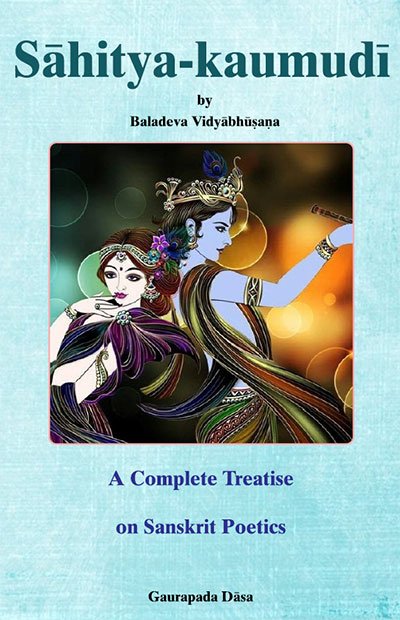Sahitya-kaumudi by Baladeva Vidyabhushana
by Gaurapada Dāsa | 2015 | 234,703 words
Baladeva Vidyabhusana’s Sahitya-kaumudi covers all aspects of poetical theory except the topic of dramaturgy. All the definitions of poetical concepts are taken from Mammata’s Kavya-prakasha, the most authoritative work on Sanskrit poetical rhetoric. Baladeva Vidyabhushana added the eleventh chapter, where he expounds additional ornaments from Visv...
Text 4.50
उदाहरणम्,
udāharaṇam,
This illustrates rasābhāsa (semblance of a rasa):
gāndharvi kurvāṇam avekṣya līlām agre dharaṇyāṃ sakhi kāmapālam |
ākarṇayantī ca mukunda-veṇuṃ bhinnādya sādhvi smarato dvidhāsi ||
gāndharvi—O Gāndharvī (“female Gāndharva”); kurvāṇam—who is performing; avekṣya—after seeing; līlām—pastimes; agre—in front; dharaṇyām—on Earth; sakhi—O friend; kāma-pālam—Balarāma[1]; ākarṇayantī—while listening; ca—and; mukundaveṇum—to Mukunda’s flute; bhinnā—split; adya—today; sādhvi—O chaste woman; smarataḥ—because of Cupid; dvidhā—twofold; asi—You are.
O sakhī Rādhā, today, upon seeing Balarāma’s pastimes on Earth and giving ear to Mukunda’s flute, You, a chaste woman, were split in two by Cupid. (Bhakti-rasāmṛta-sindhu 4.9.16)
atra bale kṛṣṇe caikasyā ratir varṇitā.
In this verse, it is said that She has affection for both Balarāma and Kṛṣṇa.
